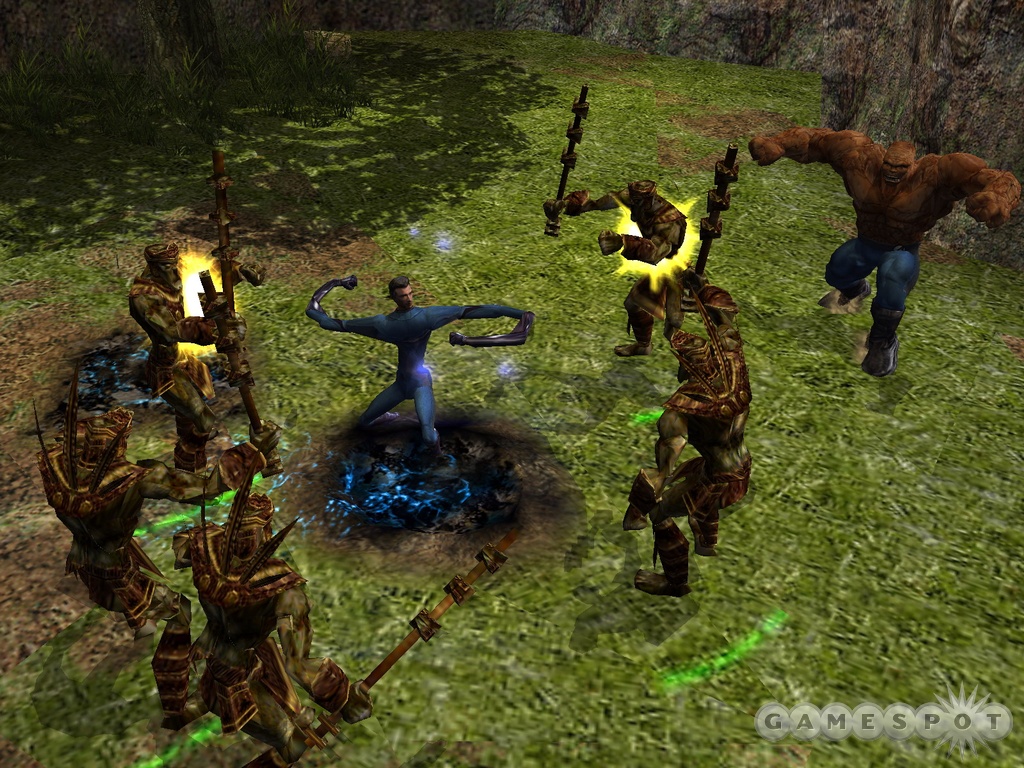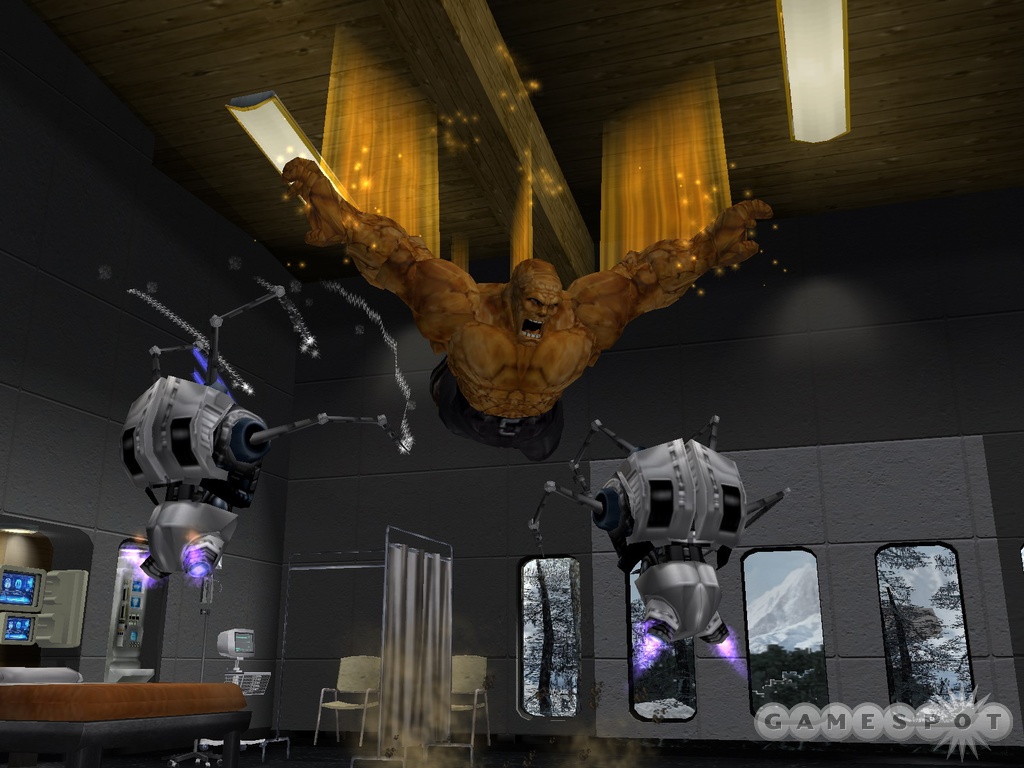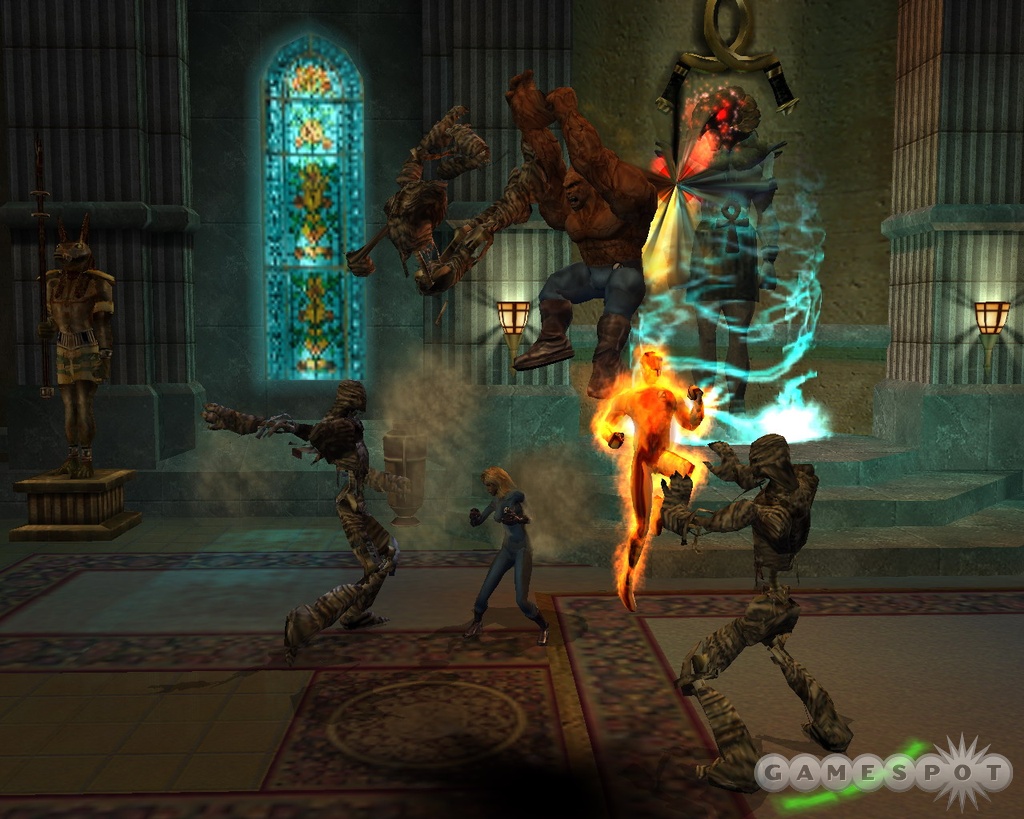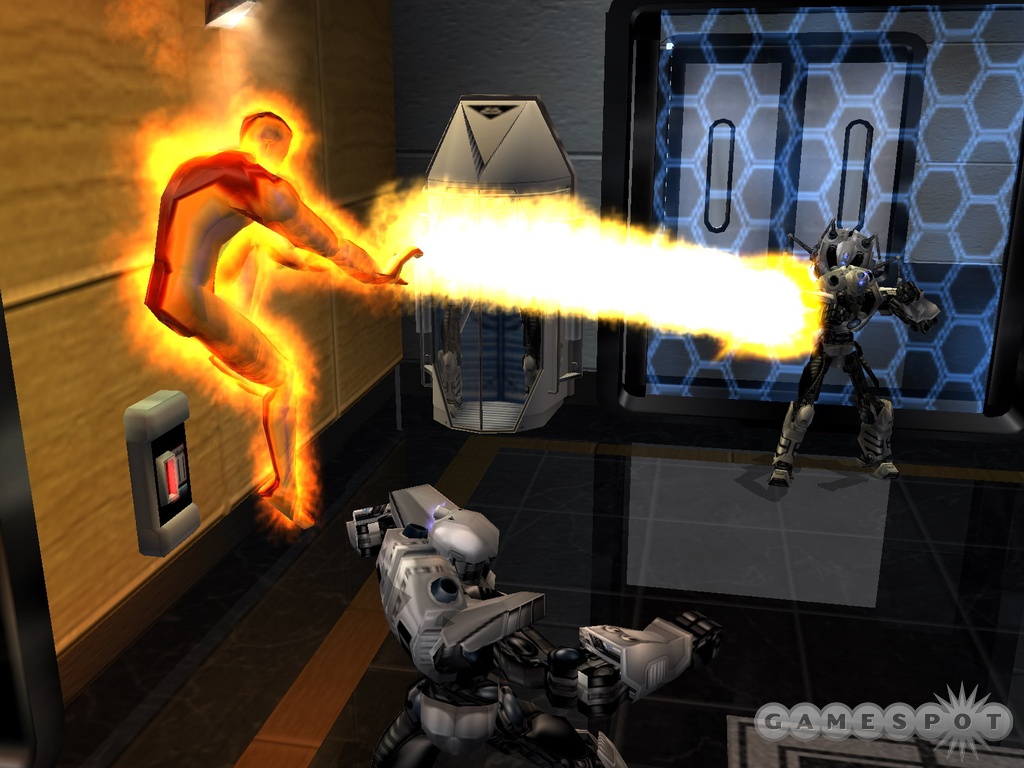Fantastic 4 Hands-On
We finally get to try out Activision and 7 Studio's action game based on the upcoming film.
With the upcoming motion picture based on Marvel's Fantastic Four comic book set to hit theaters next month, Activision recently gave us the opportunity to get our hands on the PlayStation 2 and Xbox versions of the game that's based on the forthcoming flick. The game is being developed by Los Angeles-based 7 Studios, which cut its teeth on the current generation of consoles with titles such as Legion: The Legend of Excalibur and Defender. As with most movie-based releases, Fantastic 4 will offer an experience that incorporates the film's plot but aims to offer an expanded adventure. In F4's case, this means drawing on several decades of comic history that's been built up since the team's debut in 1961, when its members first gained his or her individual powers after being exposed to a cosmic storm. Our time with the game consisted of a sampling of several levels taken from different points in the action. Though the demos made for a slightly scattered picture of the game, they also let us get a feel for the variety 7 Studios is putting into the third-person actioner, which appears to be shaping up to be quite solid.

The first area we played was set in the early part of the game, after the quartet of soon-to-be-superheroes has returned from its cosmic-storm encounter to discover its members have been changed. Though the game will let you control the whole team, this early level was essentially one of four tutorials designed to familiarize you with the core mechanics and unique aspects of Reed Richards, aka Mr. Fantastic, the elasticized leader of the team. When the level begins, you're tasked with guiding Reed out of the medical facility where he and the team are being kept. Besides the standard intro to the light and heavy melee attacking you'll engage in, the level introduces you to the character-specific minigames you'll come across as well. In Reed's case, this involves hacking locked doors by moving three concentric circles around until you've completed a circuit that lets you pass. Your primary foes in this stage include a whole lot of humanoid robots that amount to cannon fodder for you to cut your teeth on. The slow-moving foes offer ample opportunity to test out the game's combo system, as well as earn points you'll need to both earn new moves and power up existing ones.
The next level offered the same basic tutorial experience of escaping the medical facility, but from a slightly more aggressive perspective. Whereas Reed's ability to stretch like a rubber band is a useful and fairly low-key power, and one with no visible side effects, Ben Grimm's superstrength as The Thing comes with a rocky new appearance that's a little unsettling for the formerly normal-looking bloke. Ben's escape from the facility takes the form of a clobberin'-heavy beatfest that finds you mashing on robots, picking up objects around you, and using these objects to smack fools around. Ben's minigame requires you to quickly mash an attack button to build up a meter that lets him force open doors. The end of Ben's level finds him reuniting with his three friends, who talk him down from his rage-fueled rampage just in time to help them face off against a boss: a menacing robot. The final battle offers your first taste of controlling the team, which serves as a nice wrap-up to the tutorial. Controlling the team should be familiar to anyone who played last year's X-Men Legends, as the game uses the same D pad cross to let you switch between team members on the fly.

The next level we tried was set later in the game, and it found the team sporting its familiar uniforms and facing off against Diablo, the mad alchemist from the comic (not Blizzard's well-known lord of destruction), in his homeland of Tikal. Whereas the first two levels we played were set in the confines of a by-the-numbers interior, the Tikal battle dropped us in the middle of some ruins nestled in a rain forest. The boss fight was a multipart affair that had us sussing out the villain's attack pattern and getting in to do some damage when he was vulnerable. The battle was complicated by mobs of his minions that were eager to stop us. The battle provided a showcase for both the game's artificial intelligence, which guides your three other teammates when you're not in control, and the spectacular special attacks that are possible once you've bought or upgraded them.
After playing those first few levels by ourselves, we switched to two-player co-op for the next area, which was set in a museum. The level opens with a cameo from the Puppet Master, one of the team's long-standing foes and the father of Alicia Masters, The Thing's love interest. The villain brings displays in a museum to life to menace patrons and stir up trouble. The level sends you off to save innocent bystanders, destroy the Puppet Master's minions, and make your way to a final boss fight with a huge statue of the Egyptian god Horus. The level required more multitasking, due to its being set in the latter part of the game, so it had us keeping an eye on civilians, finding ways to unlock doors, participating in each of the character's minigames, and then splitting up. Several sequences found us alternating control between a pair of heroes, rather than the group, as the team split up to thwart the Puppet Master's evil plans. The quartet reunites for the Horus battle, which, like the brawl against Diablo, requires you to time your attacks and coordinate your team's efforts. Though the battle was more challenging, it's later setting granted us access to even more of the gang's special attacks.
Nick Fury: Agent of Shaft?!
The final area we played--again, in co-op--found the team infiltrating an underground facility and encountering the fearsome Dragonman, another foe from the Fantastic Four comic book. The basic thrust of the level is to follow in the villain's wake, eventually overtake him, and engage in a boss fight. While it sounds easy, the facility has all manner of hazards to contend with, some even caused by your foe, who knocks all manner of debris in your way. Whereas the museum level focused a lot of its time on The Thing and Mr. Fantastic, this level centered around the Invisible Woman and The Human Torch. The brother and sister are pitted against an assortment of robots and environmental hazards, such as fire, locked doors, and falling debris. 
Thankfully, the Torch's fire powers and the Invisible Woman's ability to project force fields make the trouble manageable. The level is set much later in the game, and, as a result, it lets you pull off some impressive cosmic-powered special moves, such as the Torch's "wall of fire" and the Invisible Woman's shield blasts. When we finally caught up with Dragonman, we wound up in one of the most difficult boss fights yet, as we had to face off on a moving elevator that has all manner of enemies dropping down to impede your butt-kicking progress. But, as always, you'll just need to both figure out his pattern and determine when to attack while contending with his cronies.
Once Dragonman was defeated, we got to catch one more cameo in the game: Nick Fury. This should be quite a surprise for comic fans. Though the former director of the government's S.H.I.E.L.D. organization is a familiar face in the Marvel universe, his incarnation in Fantastic 4 is not as the grizzled war veteran who's been around since 1963's Seargent Fury and his Howling Commandos #1. Instead, the Nick Fury here is the Shaft-like incarnation of the character introduced in Marvel's Ultimate line of comics.
We got a good feel for the gameplay in the levels we tried out and are generally pleased by how the game handles. Each character's unique attacks are generally in line with his or her powers, although some of the Invisible Woman's take some pretty steep dramatic license. But despite the odd discrepancy between the company line on the group's powers and how they work in the game, the mechanics make for fun play. We're pleased by the team attacks that let you and a friend gang up on a foe with a two-part power throw. The cosmic-powered enhanced special attacks are also fun to pull off and are very satisfying thanks to the special effects associated with them. There were a few rough spots (namely with regard to collision detection) that we'd like to see smoothed out before the game ships. But other than that, the game is solid.
The overall presentation in the PlayStation 2 and Xbox games was looking solid, on the whole. The graphics look sharp thanks to a versatile graphics engine that focuses its attention where it should: on the big four. Each of the characters looks reasonably close to his or her big-screen alter ego, and each has a good selection of special effects on hand to show off his or her unique powers. The assortment of enemies we faced ran a fairly wide gamut, from nicely done to a little rough around the edges, but there wasn't anything glaringly broken. The environments were a varied assortment of locales that sported a good amount of interactivity. Even the plainest area we were in, the medical facility at the game's start, had plenty to break. The ruins in Tikal and the locations in the underground facility were all well done and provided plenty of interesting visuals. From a performance standpoint, both platforms ran smoothly and featured the now-standard distinguishing characteristics between the PS2 and Xbox. The Xbox featured the cleaner textures and marginally better performance over the PS2. The one rough spot in both versions of the game, however, revolved around the camera, which was often problematic. Hopefully 7 Studios will be able to smooth the camera a bit before the game ships. As far as audio goes, the game featured a mix of music taken from the film, in addition to original tracks that supplemented the score. The voice acting was solid, and the movie cast helped bring the team to life.

Based on what we played, Fantastic 4 appears to have all the ingredients in place to offer a solid action experience that should complement the film. The characters are basically well represented, and their powers have translated reasonably well to the game. The story features some interesting nods to the gang's history while staying true to the film's plot. The inclusion of a wealth of unlockables and hidden objects should keep you playing, as will the multiplayer mode options. If 7 Studios can tighten up the little elements that are hampering the game as of now, Fantastic 4 should be a solid offering for action fans when it ships next month for the GameCube, PlayStation 2 and Xbox.
Got a news tip or want to contact us directly? Email news@gamespot.com
Join the conversation